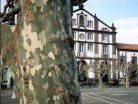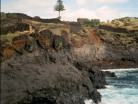São Miguel Island (Portuguese pronunciation: [sɐ̃ũ miˈɡɛɫ]; Portuguese for Saint Michael), nicknamed “The Green Island”, is the largest and most populous island in Portuguese Azores archipelago. The island covers 759 km2 (293 sq mi) and has around 140,000 inhabitants, 45,000 of these people located in the largest city in the archipelago: Ponta Delgada.
In 1427, São Miguel became the second of the islands discovered by Gonçalo Velho Cabral to be settled by colonists from the continent of Portugal. This date is uncertain, as it is believed that the island was discovered between 1426 and 1439 and inscribed in portolans from the middle of the 14th Century. In the early 1400s Infante D. Henrique authorized the settlement of the Azores, and many settlers from Estremadura, Alto Alentejo, Algarve and Madeira traveled to São Miguel, under the Carta Régia (a decree of the regency). Settlers from other countries, notably French people and cultural minorities such as Jews and Moors also came in this early settlement phase, due to the fertile soils and temperate climate. A military garrison was quickly established, and the Azorean ports became obligatory ports-of-call on African and Asian commerical trade. São Miguel became a center for the production of sugar and orchil, a dye exported to Flanders for the making of cloth.

